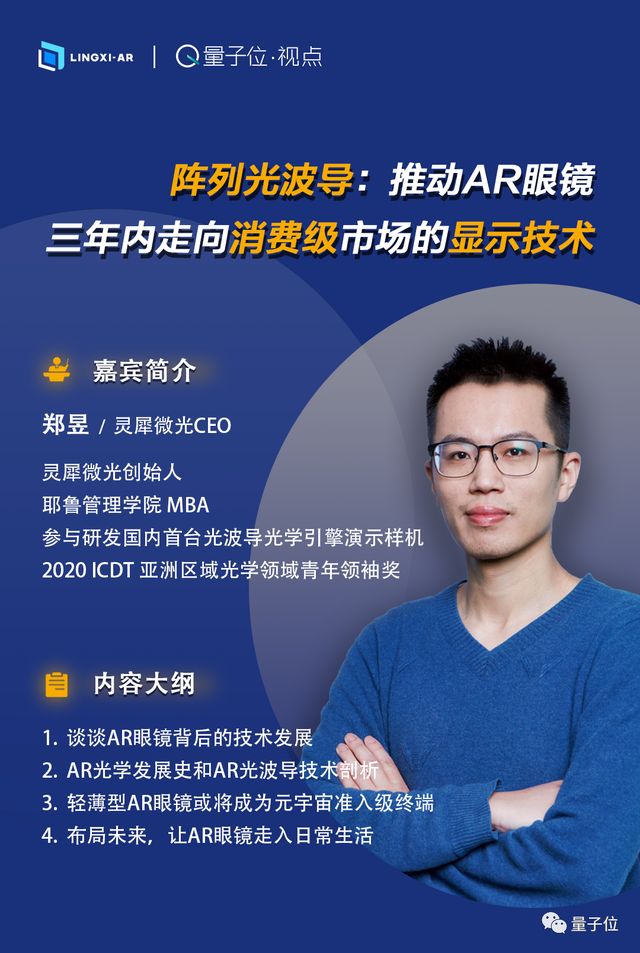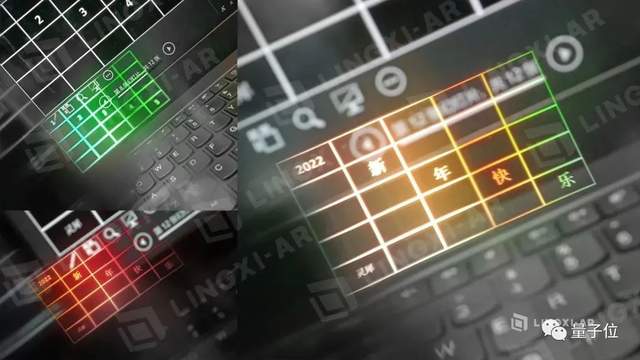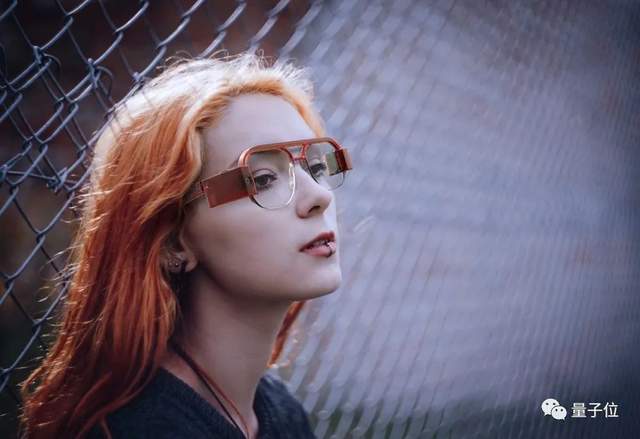Lingxi slightly light Zheng Yu: The array of light waveguides promotes AR for three years to the consumer market | quantum position · viewpoint
Author:Quantum Time:2022.06.26
Viewpoints are from the quantity of the Temple of Temple | Public Account QBITAI
The development of the Yuan universe industry is gathered together to build a new form of the next generation of Internet.
Just as the Internet access -level terminal is PC, the access -level terminal of the mobile Internet is a mobile phone, so the next -generation Internet terminal may be VR and AR devices.
The VR terminal may carry the interaction of the depth of the universe, and the popularity of the AR terminal may bring the Yuan universe technology to millions of households.
AR device, although the shape seems extremely close to ordinary glasses, its core optical display part, that is, optical module, makes it the "low threshold" terminal that hopes to open the gate of the Yuan universe.
Focusing on hot topics such as the AR industry trend and the Yuan universe, Zheng Yu, the CEO of Ling Rhino, shared his experience and viewpoints in the "quantum position · Viewpoint" live broadcast.

The following is based on the content of the sharing:
Talk about the technological development of AR glasses and behind it
Recently, the concept of the "Yuan Universe" has been fired, and the Yuan universe contains the concept of AR/VR. AR/VR is actually no stranger to us. Since Facebook's acquisition of Oculus in 2012, the concept of AR/VR is well known. It can be said to be the first year of VR in 2016. In a blink of an eye, after so many development, we expect that AR can replace our mobile phones in the future to become the next generation of mobile terminals, but it seems that this matter has not happened yet.
So many people will ask, when can it burst? When can AR/VR be like our mobile phone, can every ordinary person use? I want to say that in the face of a better future, reality is relatively cruel. The existing AR/VR equipment is also facing many problems in the overall volume, the experience needs to be increased, and the price is relatively high. This equipment is relatively high for access -type terminals, so in the C -end market, so on the C -end market, It takes a period of time to explode.
There are many points that need to be broken during this time. One of the very important points is how to make its hardware more small and cheaper. It can allow everyone to enter the Yuan universe world very low. This is what I think in the future. Very critical point.

Ling Rhino Micro -light AR Reference Model: Aladdin Zero
Inventory of the current TO C VR/AR products on the market, you can see some of the current mainstream equipment: Quest2 has sold about 15 million units. As of now, it should be the highest sales product in history; two generations The HoloLens of the product iteration is a benchmark AR product sold by Microsoft, but the price is high; at the same time, there is another product Magic Leap One, which is the image of the upper left corner of the above picture.
No matter what these glasses look like, everyone finds that it is obviously a characteristic. They are not real glasses, but a very bulky head -mounted display and a head ring -shaped design. In fact, it is difficult for consumers to accept this AR device. form.
So many people have to ask: Why do they want to make this way now and not make that lightweight glasses? I think there are two main reasons:
One reason is how to display a high -resolution image of a larger viewing corner from the display module side. The so -called big vision corner is a large picture, high resolution is a picture with clear and color contrast, which is still a difficult point in physical limit. In terms of existing technology, it is necessary to achieve such a big picture , High resolution, at the same time, the small volume of optical devices, the difficulty is still very high.
The second reason is the algorithm and computing power layer. There will always be a game relationship between computing power and algorithms in the computer world. If you want to achieve the effect of AR, such as what we think in the imagination, we can meet with virtual characters virtually. Behind the force is the high performance of the chip, but the high -performance chip must bring high power consumption and huge volume occupation at the same time.
In this regard, the existing AR/VR device is still difficult to balance, but iteration speed is also fast. I think it may take 3-5 years. Then in this process, the AR device will take two directions. One direction is to choose a smaller volume, sacrifice some computing power and picture size, so as to be extremely light.
These lightweight AR glasses can realize information reminders, navigation text reminders, and simple translation. For example, recently, Google announced the prototype of AR glasses at the press conference. It is very lightweight. Like ordinary glasses, the function of Google translated in the interior. There may be some other functions such as HUD navigation. This is the so -called "lightweight AR glasses".
During the same period, we can see that the domestic OPPO also released such products last year, but that Air Glass is a single green product, of course, the price is not expensive. So no matter whether everyone is exploring at home and abroad, it is possible to complete a consumer -grade and widely acceptable product form on this simple lightweight AR device. This is also what we have worked.
The second direction is the larger volume, but the picture is larger and the function is stronger. There is a relatively complete AR or even MR function AR glasses or AR helmet or head display, so Microsoft goes to this direction. This type of hybrid reality terminal has achieved very stunning images and interaction effects under compromise and morphological compromise. You can show your head and see virtual animals in your hands, or the virtual scenes are integrated with the real world. Sports, mechanics and scene feedback are based on strong computing power and realize integration with the real environment. In this direction, I think that Microsoft and Magic Leap One have done a lot of work, and it has also broke through many technical problems.
In fact, this direction is also more interesting, and we also have the corresponding product layout. However, problems such as the high price of this direction, the positioning of the pure to B scene, and the shape of the head display make it difficult for us to use it extensively in the real life. I personally think that there have been no benchmark products that have solved all the above problems so far.
Analysis of AR optical development history and AR optical wave guide technology
We return from the product to optics. Why is it that one of the core of AR products that integrate miniaturization and large screens, high -resolution, and high -resolution, one of the cores is also a very important driving factor is optical module.
Everyone knows that AR/VR is very different from the mobile phone at the hardware level. The most important difference is that it replaced the screen of our mobile phone with a lens to achieve the original screen that can be seen on the mobile phone, and we can we can See a three -dimensional, spatial dimension with a space with glasses. This effect is achieved through a special AR optical system.
AR's optical system must be different from our display. First of all, it can let me see a "virtual" image. Second, it cannot cover the normal light. It is difficult to meet these two requirements and at the same time, which is actually very difficult.
There are many solutions in history, such as our earliest separation optical. The most practical use of the axis light is in the field of military industry. We often see pilots wear a large helmet. After wearing it, he can see some information about the dashboard and at the same time. AR helmet.
With the development of technology, we have smaller prism solutions, namely Google Glasses. The appearance of this optical system seems to be a cubic prism block, put it in front of the user's eyes. Among them, there is a semi -anti -semi -diaphragm and anti -semi -transparent coating, so that the external light can enter the user's eyes, and at the same time, it can also put it. The light that wants to present into the eyes can form a superposition effect.
This type of prism optical solution still cannot get rid of a positive proportional relationship between the angle between the volume or the optical diameter and its imaging pattern.
In principle, the larger the image, the larger the volume, and it has been solved in a better solution in the optical waveguide plan. The optical wave guide scheme can finally cast a large image through a small thin and light lens. The positive correlation between the size and the volume of the lens can achieve a better balanced relationship under the optical wave guide system. In the ideal state, the light wave guide transmission system can use a thin piece of thin slice as the optical lenses to realize the view of nearly a hundred inches of projection screen at 3 meters distance.
The picture presence under the ultimate lightness is the essential difference between the light wave guide compared to the bearing optical, prism imaging, and free curved surface. The core is that the optical wave derivative has the re -combined combination and amplification of micro -display screens. We can call it call it. It is the pupil expansion system.
As corresponding to the figure, the pupil expansion system is simply transmitted to the array area created by the optical path through the light path to the array area of the special process, which is the waveguide transmission part. This process makes the overall optical system. Can be expanded and finally coupled to the eye.

In the field of research, the technical route of the optical waveguide began to be widely discussed from 1990-2001, but at that time, it was limited by the immature process and the difficulty of electronic devices miniaturized, so it was not widely used in large scale.
But since 2015, integrated circuits have developed leap -up. In the development process of mobile terminals, the smaller and smaller the electronic devices are, and the higher the chip integration. Therefore, after the electronic section can be reduced, the importance of AR's optical module to the light of light -light optical waveguide is becoming increasingly emerged.
Then on the light wave guide route, according to its different manufacturing process and design concept, you can continue to subdivide. At present, there are three directions -the glory waveguide, relief grating, and holographic of the geometric arrays. So who is the future on such a big route for the development of a light wave guide?
There is no standard answer at this question. Just like before the emergence of Apple iPhone, there are many forms of smart phones. Regarding the screen selection of smart machines, whether to use resistance screens or multi -touch capacitor screens. It is a question. In fact, various manufacturers are pursuing the answer to the correct route.
So in the benchmark products, everyone is guess which one will be in the end. This is a betting on the technical direction. Each company has its own solutions and different understandings. Whether it is foreign companies, domestic companies, startups or large companies, the current optical solution is not standardized. So on these technical routes, I simply make a comparison of effects.
Judging from the current results, geometric array optical wave guides are a relatively large advantage. Mainly reflected in these points:
The first is the high use of light energy. The use rate of light refers to a part of the light from the display light source. How many light on the lens can be received and entered the eyes. The higher the optical utilization rate of the light wave guide module. Similarly, the light that reaches the user's eyes under the same light source, the less energy is required, the more conservation of the power consumption. This is a very important indicator.
Typical products, for example, Microsoft HoloLens uses surface relief light grids to make display systems. It needs to block the external light to enter the human eye. The reason behind this design is that the light utilization rate of the surface relief shirt it uses is relatively low, and the light of the virtual picture itself is not very strong. Therefore, when the outside of the outside world comes in image.
Then in this indicator, the geometric array lit wave guide has a relatively large advantage. Because it uses this array reflector, and the surface relief ranch is limited by the principle of multi -pole diffraction, its color will have this scattered phenomenon in other aspects in addition to the light we want. This will cause a very important problem. We call the front light, that is, in addition to investing in our eyes, the light source is also investing out.
If you can see the light transmitted from the outside, it means that you also find that there is a image on the outside of the lens, which is not good news for the protection of personal privacy and the comprehensive experience of the wearer.
Secondly, the array of optical wave guides is more thorough than the color dispersion problem. In other words, when looking at a pure white picture, the entire picture shows completely uniform white, or some of each picture is red, some are blue. This color uniformity of color uniformity controls the optical system that is not in place, has a great impact on the perception. Imagine if you are watching TV when watching TV, it is almost impossible to accept consumers.
The color uneven phenomenon is still more serious in the surface relief grating scheme. This is due to the use of the diffraction grating, which is more sensitive to the light wavelength, or the optical device that has a strong selective spectrum to do it to do it. Coupling or coupling system will eventually present this phenomenon.
Then, the angle and volume control. This is the advantage of the optical waveguide system, but its embodiment of the optical wave guide will be more vivid. For example, the module product with the upcoming viewing angle of Ling Rhino's micro -light has reached 60 degrees. Based on the optical display during the full reflection period, the light wave guide shows higher refractive index compared with other schemes. The higher the refractive index of the light waveguide lens, the less light that can be transmitted in the light wave guide without escaping. In this case, the larger the viewing angle.
Finally, the advantage of lightness. From the perspective of thickness, the light wave guide shows a natural advantage compared to other solutions: surface relief grids usually need monochrome to display monochrome. Politaire and holography can reach a single -piece color display scheme, which makes it closer to ordinary optical lenses and can even be thinner.
Light and thin AR glasses may become the terminal of the Yuan universe
Then, based on the above content, many people will continue to ask me other questions: the end of the development of optical waves, relief grating, and full -interest development of the vitamin, whether these schemes can gradually solve the problem with iteration, which solution is most likely to be combined in the future in the future. Enter AR glasses to make it the role of the entrance of the Yuan universe?
From the current perspective, such as the color problem in the surface relief grating scheme is essentially limited by the physical characteristics itself. I can only say that starting from Nokia's first -to -surface relief grid to make the principle patent of making light waveguide devices, it has been 20 years since it has been seen. This problem has not seen significant improvements.
In addition, in the past 20 years, the relief gills have not actually had a good mass production plan, or better, from mass production and design, solve this problem. Will these problems be solved in the next 20 years? I think it is possible, but the hope is slim.
Including Microsoft, as a leading company in the AR industry, HoloLens1 was released in 2014. Today's HoloLens2 has not solved the above problems well.
In addition, there is a problem of light energy utilization. At present, the surface relief grid and the holographic solution have not been better solved in the low optical energy utilization rate.
From the analysis of the light source, why the Micro LED is noticed because it is essentially more than 100 times higher than the current Micro OLED pair. For the solution of the relief grating, the disadvantage of the use of light can be localized, but the problem of dispersion may be more serious. Moreover, Micro LED has not yet achieved mass production, and the highlight utilization rate is also solved in the process of exploration when the highlights are available in battery life. The maturity of Micro LED still takes 3-5 years, especially in color, which is why the domestic OPPO AR glasses choose a single green. The road of Micro LED is still very long, so I won't talk about it in detail.
Regarding this technology, there are many difficulties to be solved by the relief grating: for example, the light transmission rate, the light -light array guidance scheme of the spirit rhino can be made very transparent. It is necessary to cover part of the light outside; for example, the color unevenness, in the pure white picture, the color presentation is not absolutely consistent; but also the limit clarity, you can intuitively see the comprehensive influence of the above problems.
From the perspective of cost and mass production, there are currently different opinions in the industry. In major news media, everyone has their own views. But from my perspective, the development of this piece will make great progress in these 5 years.
Just as Tesla's battery was initially considered to be unable to make it, Apple's high -precision capacitor touch screen had great mass production difficulties at the beginning. So I think mass production depends on how fast the development is. It seems that in the past two years, Ling Rhino, as a domestic optical waveguide manufacturer, has achieved substantial results in the array of light waveguide solutions. As the cost continues to decline and the yield continues to increase, we achieved a large mass production of 85%in 2018.

Then, according to the space for future costs, I think the cost can be reduced to about $ 50 or even lower. If it drops down, there may be some difficulties that need to break through.
In the long run, in the three schemes, if the assumptions are the same or the display effect is close, the cost of the ghost of the gale can be the lowest, because it is mainly produced by exposure technology. In short, it is a bit like us doing it. The working principle of laser etching similar laser equipment is more efficient. Correspondence holographic is currently the direction of our long -term investment, and it is also the core technology of international factories. The body interest is interfered through two beams of laser, and then exposed on one material. As long as these conditions are stable, it can make molding lenses quickly and efficiently, and the stability is relatively good.
But the ideal is full, and the reality is very skinny. I think the entire industry's entire industry is still in an extremely early stage of development. In the early stage, its fixed asset investment will be relatively large, and there are also some errors encountered in the middle of the process to be resolved. In addition, the templates required for pressing the printing will also encounter loss. There is room for improvement in this direction, but it is still difficult.
For the time being, the maturity of the skilled holographic technology is developing steadily. This is mainly reflected in some foreign equipment manufacturers that can make mature equipment, can make a good process of nano -printing, and the yield is gradually rising, but it is limited by the nanocale itself. The accuracy of the grating is limited, and the process is very difficult.
Ling rhinoly microman holographic picture real shot
In China, short -term must be a combination of products accumulated in the mature technology and mass production process of optical waveguide, which can give priority to entering the consumption level. The Lingxi Micro light is expanding the production line to realize the vision of light wave guide, and at the same time promotes the completion of the domestic holographic production line and small batch production lines in 2023.
Let ’s share with you the technical breakthroughs of Ling Rhino Microle in the direction of the light wave guide. Our latest array light wave guide film has achieved the brightness of the 60 ° viewing angle of 60 ° to about 1000 Nit. The resolution of 1080P can be relatively mature. In particular, we have solved the problem of two -dimensional pupil expansion. This allows us to make the lens even thinner and the overall module is smaller.

Through this video, we can see that we can achieve a better AR perspective effect, which is controllable from color and contrast. This is the effect of our actual shot in the office.
We actually did a lot of work on the codes of holographic:
In terms of theory simulation: Use Virtuallab commercial software to coupling the angle of the holographic grating, diffraction efficiency, angle bandwidth, and preliminary simulation of principles. In terms of coded holographic grating waveguide system: Realize red and blue single pieces, and tested by red and green single -chip guidance to complete the trial production of single -piece two -color waveguide shooting and single -chip three -color waveguide sample. In terms of the development of caddy holographic materials: Mastering polymer decentralized liquid crystal configuration formulas to perform polymer decentralized liquid crystal -related synthetic equipment construction and polymer decentralized liquid crystal -related synthesis, and the first batch of materials have been completed. Aspect of the overall design of the light machine: complete the overall design of the light machine of single green holographic waveguide, conduct a single green holographic waveguide module for trial production; complete the optical design of full -color small -caliber light machine (projection light machine part). The Ling Rhino Micro -optical wave guide module series applies different scenarios. For example, the consumer series we have lightweight approximation of the AW70PRO of the lens, and the AW81 of the security scene, which mainly targets the head -of -the -art optical solution such as HoloLens. In addition to the more small, more mature and lower cost of optical modules, there is also a very important direction to make AR glasses look better. Everyone can accept lighterweight, and then experience better.
In order to promote the development of the industry, we have also made a full set of reference plans. Aladdin Zero, this is the reference plan based on the optical module of the glory of the rhinoceros.
Aladdin Zero's reference prototype weighs only 38.6 grams, which is the most magnificent AR glasses in the world. As a reference plan for the downstream, it allows everyone to use a hardware development package to develop the functions they want. These functions include B -end scenarios such as medical, industry, security, and military, as well as future C -terminal scenes. For example, entertainment, education, tourism, new retail, etc. are now a blue ocean, so I think the Yuan universe is the biggest opportunity for the AR/VR industry chain.
Ling Rhino Micro -light AR Reference Model: Aladdin Zero
We hope that more downstream or more manufacturers do AI glasses can participate in the design of AR glasses in combination with more content application scenarios, so that the AR industry can develop vigorously. In response to this vision, we will continue to launch a new generation of reference model products this year. Please look forward to it!
Laying the future, let AR glasses walk into daily life
In addition to products, we have also made a lot of attempts in the application scenario.

In response to the medical scenario, we launched a translated glasses with our customers in seven or eight years ago. At that time, we were translated for the deaf and dumb people. Communicate directly and smoothly with normal people.
We have also created AR glasses for industrial scenes. Staff can liberate hands through the screen in front of the eyes, so that information such as circuit diagrams can be presented directly in front of the eyes. Wait for work. This is significantly improved for the efficiency of industrial scenarios.
The purpose of AR glasses is glowing and heat at all walks of B -end. From B to the C -end, it is a process of market precipitation and development, and it is also the process of maturity in all aspects of AR glasses. In this process, the Lingxi Micro -Light Society has always insisted on walking at the forefront of AR optical research and development to promote the landing of the domestic AR industry.
About "Quantum · Viewpoint"
The CEO/CTO series sharing activities initiated by quantum positions are irregularly invited to invite the CEO/CTO in the field of start -up technology in the field of science and technology to share the latest strategies, technology, and latest products of the company, and discuss cutting -edge technical theory and industrial practice with the majority of practitioners and enthusiasts. Welcome everyone to pay more attention ~
- Finish -
Quantum QBITAI
Pay attention to us, and learn about the frontier technology dynamics for the first time

- END -
2022 Scientist Spirit Education Base 丨 Institute of Animal Research, Chinese Academy of Sciences

A few days ago, the Ministry of Education, the Ministry of Science and Technology,...
The "Three Boxing Combinations" in Yantai High -tech Zone promoted "Get Layout and Starting" and entered the new normal

Focusing on optimizing the business environment and promoting the reform of the ap...